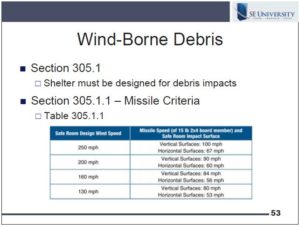Wind-borne debris is without a doubt a very serious design consideration when approaching a storm shelter or safe room design. In every tornado or serious wind event, there are devastating images of the effects from upturned trees, 2x4s, cars, and even large fuel tanks. Designing for such impacts can be daunting, and present day engineering theory may not be sufficient to effectively codify such impact forces. So what is a structural engineer to do when faced with protecting the public from these life-threatening debris impacts?
In December 2017, Jason Pirtle, PE from Jason Pirtle Structural Engineers, Inc., gave a presentation on Tornado Shelter Design. Jason reviewed the requirements laid out in the 2015 IBC, discussing which occupancies are required to have storm shelters designed in accordance with ICC 500. Jason covered the various structural design considerations which need to be considered including the effect of wind-borne debris.
Storm shelters are required to be designed to withstand wind-borne debris due to the abundant missile supply available during a storm event. Jason referenced Table 305.1.1 in ICC 500, as shown in the slide below, which designates the missile speed of a 15 lb 2×4 board for various design wind speeds that shelters need to accommodate. The Code designates required missile impact testing for assemblies to be used in storm shelters as laid out in Sections 305, 306, and 804 of ICC 2015. These testing requirements all but eliminate design calculations for debris impact, however close inspection during construction should be followed to ensure the as-built shelters is in accordance with the specified tested assembly.
Since the Code requires that constructed materials be tested before use, Jason suggested both the National Wind Institute at Texas Tech University as well as FEMA P361 as good resources for finding tested wall and roof assemblies. The National Wind Institute offers this valuable listing of tested assemblies that have a ‘PASS’ rating for the requirements of ICC 500 for various wind speeds and missiles. Additional information about missile testing can be found at the Debris Impact Facility at Texas Tech University. Jason also mentioned checking with window and door manufacturers to verify tested building components’ compliance.
Additionally, Jason reviewed how site specific debris hazard must also be considered in any shelter or safe room. It is important to note that these site specific hazards may require additional testing beyond the code required minimum tests for your project. However, the resources included here offer a good starting point for specifying appropriately tested materials for use in your next storm shelter project, and remember, the entire shelter, including openings, must be constructed with tested components capable of resisting the missile impact!

